Laporan/Prosiding
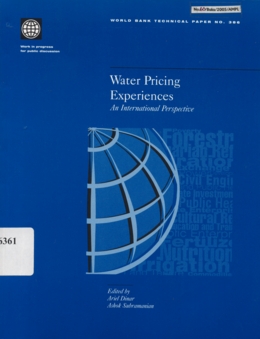
Water Pricing Experiences: An International Perspective (World Bank Technical Paper No.386)
Ariel Dinar & Ashok Subramanian (Ed)
Th.
980
Water pricing is an important way of improving water allocation and encouraging user to conseve scace water resouces. Price witch accuarately reflecs waters economic, or scarcity value give information to users, witch they use to make choices regarding water consumtion and use. This water pricing can effect water use efficiency, at both the individual and social level. In practice water pricing schemes may be designed to meet many objectives: policymakers may wish ti discriminate among diferent categories of users or use water charges ti raise revenues for general purposes. Because different levels of decisionmakers may interpret such pricing policies differently, this can lead to undesirable outcomes and, sometimes, to disputes.
This work present water pricing experiences across 22 countries in various sectors and over time. Country case strudies are presented in a structured form allowing easy comparison of result. The information shows that countries have different reasons for charging for water, including cost recovery, redistribution of income, improvement of water allocation, and water conservation. Pricing schemes often comprise both fixed and varible components. Fixed prices vary greatly across countries, reflecting countries various objectives in charging for water. However, volumetric charge for urban and agricultural water are relatively similar across countries. But per meter charges for industrial water vary more widely across countries, reflecting the different use of subsidies and the inclusion taxes that vary by industry.
For urban and agriculturul water, all developing countries, and some developed countries, set charges on the basis of averege rather than marginal cost of supply. Countries do not generally adjust charges by region even though the costs of supplying water may vary greatly across regions. Agricultureal water users generaly pay something for the operations and maintenance cost of irrigation systems, ranging between 20 - 75 percent of total cost. Few countries attempt to recover capital costs from user.
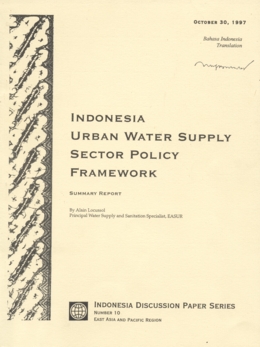
Indonesia Urban Water Supply Sector Policy Framework: Summary Report (Indonesia Discussion Paper Series number 10, October 30, 1997) Bahasa Indonesia
Alain Locussol
Th.
924
Laporan ringkasan ini berupa terjemahan Seri Indonesia discussion paper (Number 10) East Asia and Pacific Region Country Departement III tentang kerangka kebijakan sektor air minum perkotaan di Indonesia.
Daftar isi:
Ringkasan Eksekutif
A. Pendahuluan
B. Sektor Penyediaan Air Minum Perkotaan Selintas
C. Masalah Utama yang dihadapi Sektor Air Minum Perkotaan
D. Tantangan Ke depan
E. Unsur-Unsur Penting Kerangka Kebijakan
Tabel-Tabel
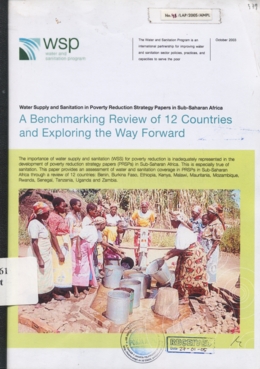
Water Supply and Sanitation in Poverty Reduction Strategy Papers in Sub-Saharan Africa: A Benchmarking Review of 12 Countries and Exploring the Way Forward
Th.
882
The Importance of water supply and sanitation (WSS) for poverty reduction is inadequately represented in the development of poverty reduction strategy papers (PRSPs) in Sub-Sahara Africa. This is especially true of sanitation.
This paper provides an assessment of water and sanitation coverage in PRSPs in Sub-Sahara Africa through a review of 12 countries: Benin, Burkina Faso, Ethiopia, Kenya, Malawi, Mauritania, Mozambique, Rwanda, Sinegal, Tanzania, Uganda and Zambia.
The paper explores three questions: What is the nature of the opportunity presented by the PRSP and HIPC initiatives for the WSS sector id Sub-Sahara Africa , What is degree of WSS coverqage in PRSPs in Sub-Sahara Africa , How can WSS coverage and incorporation into PRSPs be improved
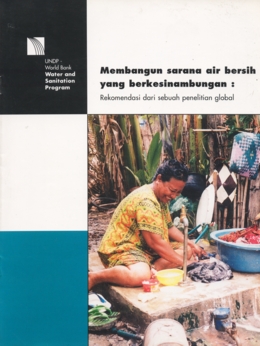
Membangun Sarana Air Bersih yang Berkesinambungan: Rekomendasi dari Sebuah Penelitian Global
A. Lambertus (penterjemah)
21 Februari 2004
1.151
Penelitian ini menunjukkan bahwa pembangunan sarana air bersih dengan pendekatan yang tanggap terhadap kebutuhan akan menjamin kesinambungan sarana air bersih yang dibangun.
Namun ditemukan pula, bahwa proyek yang pada hakekatnya menerapkan pola pendekatan ini, tidak melaksanakannya dengan konsisten pada masyarakat di lokasi binaannya. Agar pola pendekatan ini efektif, penelitian menunjukkan perlunya suatu prosedur penyampaian informasi yang lengkap yang disampaikan hingga ke tingkat keluarga/ warga, pemberdayaan masyarakat perlu dilaksanakan di seluruh tingkatan dan lapisan, dan penanggung jawab program perlu mendapatkan re-orientasi sehingga memungkinkan masyarakat penerima untuk mengelola sendiri investasi pembangunannya.
Salah satu faktor penting lainnya adalah keberadaan lembaga formal yang bertanggung jawab terhadap pengelolaan sistem air bersih dan senantiasa memberikan penyuluhan berkala terhadap keluarga/ warga pemakai. Pelatihan pengoperasian dan pemeliharaan (O&P) kepada lembaga pengelola dan mutu konstruksi juga mempunyai korelasi positif terhadap kesinambungan sarana air bersih, walaupun tidak selalu konsisten di satu negara dan negara lainnya.
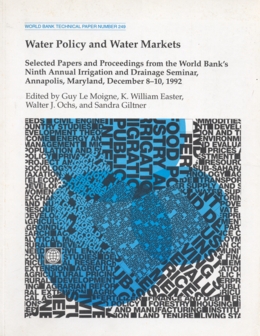
Water Policy and Water Markets: Selected Papers and Proceedings from the World Bank
Guy Le Moigne, K. William Easter, Walter J.Ochs, and Sandra Giltner (Ed)
Th.
880
This volume presents selected papers and proceedings from the World Bank's Ninth annual Irrigation and Drainage Seminar held December 8-10 1992 in Annapolis, Maryland. The volume has three sections. Section I (Water Policy) has the text of a keynote address on water issues in the Middle east and North Africa plus portions of the executive summary of the World Bank's 1993 water resources policy paper and a paper emphasizing the use of a model to influence policy decisions in China's Yellow River Basin. Section II (Irrigation and Drainage) reviews the World Bank's irrigation and drainage experience and the attitudes of water resources professionals toward problems in this area. Section III (Water Markets) contains seven papers on general aspects of water markets, observations on their suitability for several regions of the world, and case studies including Chile, the western United States, Mexico, and Spain.
Contents:
Foreword
Abstract
Glossary
Section I: Water Policy
The Strategic Role of Water in Regional Cooperation and Peace in the Middle East and North Africa
The World Bank's Water Resources Policy
Section II: Irrigation and Drainage
Application of A Basin-Level Model to the Yellow River
A Review of World Bank Irrigation Experience
How Irrigation Could be Improved: Results of a Survey of Professionals
Section III: Water Markets
Observations on Water Markets for Irrigation Systems
Chile's Market-Oriented Water Policy: Institutionsl Aspects and Achievements
The Use of Water Pricing to Enhance Water Use Efficiency in Irrigation: Case Studies from Mexico and the United States
Conditions for Successful Water Marketing
Relevance of Water Market Concept in Central Asia
Water Markets in South Asia
Water market Opportunities and Concerns: Workshop Report

Stimulating Additional Financing: Philippines Water and Wastewater Projects Final Report
Ronald Johnson, dkk
Th.
885
Daftar isi:
1. Introduction
2. Demand for Capital
3. Capital Supply for Water and Wastewater Financing
4. Institutional and Policy Issues
5. Potential Donor Financial Roles
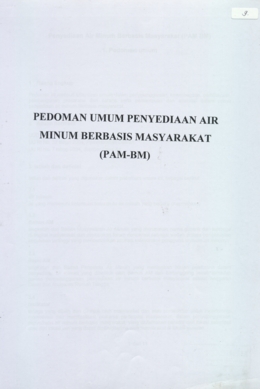
Pedoman Umum Penyediaan Air Minum Berbasis Masyarakat (PAM-BM)
Th.
1.200
Pedoman ini meliputi ketentuan umum dalam penyelenggaraan, kelembagaan, pembiayaan, pembangunan prasarana dan sarana serta pemantauan dan evaluasi dalam upaya penyediaan air minum berbasis masyarakat.
Daftar Isi:
1. Ruang Lingkup
2. Acuan Normatif
3. Istilah dan Definisi
4. Pendekatan
5. Penyelenggaraan PAM BM
6. Kelembagaan
7. Pembiayaan
8. Pembangunan Prasarana dan Sarana
9. Pemantauan dan Evaluasi
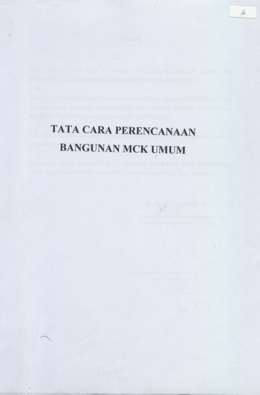
Tata Cara Perencanaan Bangunan MCK Umum
Th.
3.448
MCK umum adalah sarana umum yang digunakan bersama oleh beberapa keluarga untuk mandi, mencuci dan buang air di lokasi pemukiman yang berpenduduk dengan kepadatan sedang sampai tinggi (300-500 orang/Ha).
Tata cara ini meliputi istilah dan definisi, persyaratan yang berlaku untuk sarana ruangan MCK yang terletak di lokasi permukiman padat, dengan beban pemakai maksimum 200 orang. MCK umum dapat merupakan satu kesatuan bangunan atau terpisah-pisah untuk mandi, cuci dan kakus. Tata cara ini dapat digunakan sebagai acuan bagi perencana dan pelaksana dalam membangun MCK umum.
Daftar Isi:
Prakata
Daftar Isi
1. Ruang lingkup
2. Acuan Normatif
3. Istilah dan Definisi
3.1 MCK Umum
3.2 Air Bersih
3.3 Perangkap Air
3.4 Lubang Pembersih
3.5 Plambing
3.6 Satu Kesatuan MCK
3.7 Sistem Ven
3.8 IPAL
3.9 Sistem Drainase
4. Persyaratan mandi cuci kakus umum
4.1 Persyaratan umum MCK
4.2 Lokasi
4.3 Kapasitas Pelayanan
4.4 Sistem Penyediaan Air Bersih
4.5 Bahan Bangunan
4.6 Konstruksi
4.7 Plambing
4.8 Sarana Kamar Mandi
4.9 Sarana Tempat Cuci
4.10 Sarana Kakus
Lampiran A: Contoh Perhitungan
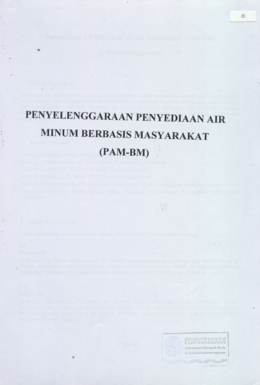
Penyelenggaraan Penyediaan Air Minum Berbasis Masyarakat (PAM-BM)
Th.
1.000
Pedoman ini memuat tata cara penyelenggaraan yang mencakup uraian yang menyangkut pelaku terkait dan tahapan kegiatan serta prinsip pelayanan kepada masyarakat dalam rangka penyelenggaraan PAM BM. Pedoman ini dapat digunakan sebagai acuan bagi para pelaku terkait dalam pelaksanaan pembangunan prasarana dan sarana PAM BM yang mandiri dan berkelanjutan.
Daftar Isi:
1. Ruang Lingkup
2. Acuan Normatif
3. Istilah dan Definisi
4. Koordinasi penyelenggaraan PAM BM
5. Tahapan Penyelenggaraan kegiatan PAM BM
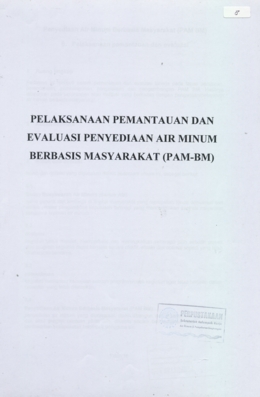
Pelaksanaan Pemantauan Dan Evaluasi Penyediaan Air Minum Berbasis Masyarakat (PAM-BM)
Th.
1.016
Pedoman ini meliputi sistem pemantauan dan evaluasi kinerja pada tahap persiapan, perencanaan, pembangunan, pengelolaan dan pengembangan PAM BM. Hasilnya dilaporkan pada perorangan atau institusi yang berkaitan dengan pengadaan/pelayanan air minum berbasis masyarakat.Daftar Isi:
1. Ruang Lingkup
2. Acuan Normatif
3. Istilah dan Definisi
4. Pemantauan
5. Tingkat Pemantauan dan Evaluasi
6. Sistem Informasi dan Pelaporan
7. Daftar Simak Pemantauan dan Evaluasi
8. Mekanisme Pengaduan dan Penyelesaian Masalah
